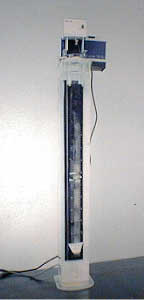Abrasion Testing
Accelerated Life Testing
Chemistry Laboratory
Computer Modeling
Salt Spray Testing
Density
Electrical Properties
Electron Microscopy
Experimental Foundry
Failure Analysis
Hardness Laboratory
Heat Treatment Studies
Light Microscopy
Lubrication Testing
Machine Shop
Materials Databases
Mechanical Testing
Metallography
Paint & Coatings
Product Testing
Rolling Mill
Thermal Testing
Density Testing: ASTM D1505 & More
ASTM D1505 is probably the most sensitive, but also the most painstaking and expensive. Values to five decimal places are obtained.

Density by Variable Density Gradient Column – ASTM D1505
ASTM D1505 uses a graduated glass column which is charged with two solutions, such that one is greater than and one less than the density of the material to be tested. The liquids are charged into the column by slowly adding varying amounts of each using a special charging system. The liquid at the bottom of the column is of the greater density and, as the column is filled, the density decreases until the top of the column contains only the lighter density liquid. The density gradient will be uniform through the length of the column. Standard glass spheres of known, but varying density are introduced into the column along with the specimens using a charging basket. This basket is slowly lowered through the column without disturbing the density gradient distributing the glass spheres and specimens according to their relative densities. Using the glass spheres as reference points, the density at the locations where specimens are neutrally buoyant is calculated by interpolation. ASTM D 1505 is probably the most sensitive, but also the most painstaking and expensive. Values to five decimal places are obtained. This method can be extended to high density materials if suitably dense liquids can be selected.
Reference: ASTM D1505 Standard Test Method for Density of Plastics by the Density-Gradient Technique.
A number of other methods for the measurement of density, including the following:
Density by the Water Displacement (ASTM C 693)
Density by water displacement (Archimedean density) since liquids other than water can be used for materials with densities less than 1.0 grams/cm3. This method allows determination of the density in air compared to its displacement in water or other liquid of known density. Depending upon the nature of the specimen (e.g., open or closed cell), the resultant value may deviate from the true mass.
A clean specimen is weighed accurately in air using a laboratory balance. The same specimen is weighed while suspended in water or other liquid of such density that the specimen will sink. Deducting the mass of the suspension wire from the weight in liquid, the volume of the specimen is calculated from the effect of displacement by a liquid of known density (Archimedean principle). This allows the determination of density of specimens with irregular shapes, uneven surfaces, or porosity. Caution must be exercised to assure that no air is trapped within the specimen. Placing the specimen in a vacuum while submerged in the displacement liquid will usually avoid error.
Dry Bulk Density (ASTM C 559, C 838, C 830)
Several ASTM methods describe procedures for determining dry bulk density. All use basically the same procedure where the apparent volume of a regular shape (usually a rectanguloid) is determined by measurement of its dimensions. The mass is determined using a laboratory balance and the density calculated as: weight (mass)/unit volume. Dry bulk density is used in the calculation of thermal conductivity per ASTM C 177.
Pore Volume and Pore Size Distribution by Mercury Intrusion
Non-wetting fluids, such as mercury can be forced into pores within a solid material by application of pressure. The pressure required is inversely proportional to the diameter of the pore or capillary through which the mercury must pass. In this method, the total pore volume and the distribution of pore sizes of a solid sample is determined by incrementally increasing the pressure of a mercury column above the sample and measuring the change in mercury height. Pressures as high as 33,000 psi can be employed to examine pores from 360 (m down to 0.0055 (m in diameter. Total intrusion volume, total pore surface area, mean and median pore diameter, material bulk density, apparent (skeletal) density, and percent porosity can be determined by this method for a variety of solid materials.
True and Apparent Density by Helium Pycnometry
This method provided a more rapid and more accurate measurement of true densities that does the Archimedean technique. Ceramics, metals, slurries, pastes, pigments, plastics, mineral matter, building materials, and other materials can be examined by this method, which has density resolution of 0.0001 g/cc. Helium, under precisely-known pressure, is used to fill small voids within a specimen. The volume change of helium in a constant volume chamber allows determination of solid volume. The ratio of sample mass to its true (sold) volume gives its true density. The volume of porosity open to the sample surfaces can also be measured, allowing determination of apparent (skeletal) density or analysis of open-cell foams. Sample volumes of up to 100 cc can be examined and the data collected in minutes through a RS-232 computer interface.

